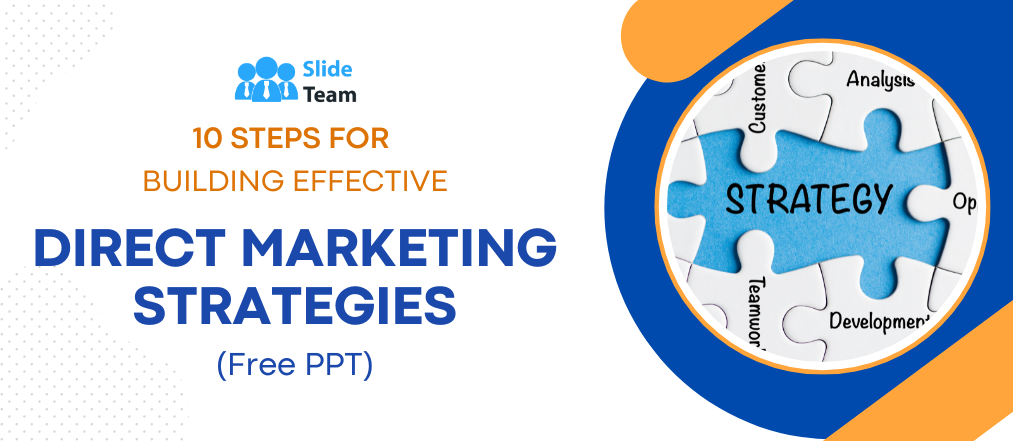Direct marketing is still a potent tool for firms to establish a personal connection with their target audience in the digital age, where customers are flooded with countless adverts and promotional content. Direct marketing strategies allow you to cut through the noise and engage potential customers directly, fostering meaningful interactions and driving conversions. In this guide, we'll walk you through the steps of building effective direct marketing strategies that yield tangible results.
Step By Step Guide for Building Effective Direct Marketing Strategies
Step 1: Define Your Target Audience
Effective direct marketing begins with a deep understanding of your target audience. Who are your ideal customers? What are their preferences, needs, and pain points? Conduct thorough market research and segment your audience based on demographics, psychographics, and behavior. The more precise your audience definition, the more tailored and relevant your direct marketing efforts will be.
Step 2: Set Clear Objectives
Every marketing strategy should have well-defined goals. Determine what you aim to achieve through your direct marketing efforts. Are you looking to generate leads, increase sales, enhance brand awareness, or drive website traffic? Clear objectives will guide your strategy and help you measure its success.
Step 3: Choose the Right Channels
Direct marketing can take various forms, from traditional methods like direct mail and telemarketing to digital avenues such as email marketing, social media, and SMS campaigns. Select the channels that align with your audience's preferences and behaviors. A multi-channel approach can amplify your reach and impact.
Step 4: Craft Compelling Content
Content is king, even in direct marketing. Develop content that resonates with your target audience's interests and needs. Whether it's a personalized email, a social media post, or a direct mail piece, the content should offer value, address pain points, and provide a clear call to action (CTA).
Step 5: Personalization is Key
In a world of mass communication, personalization stands out. Use the data you've collected to personalize your direct marketing messages. Address recipients by name, recommend products based on their past purchases, or tailor content to their specific interests. Personalization not only increases engagement but also builds a sense of rapport with your audience.
Step 6: Timing and Frequency
Timing plays a critical role in direct marketing success. Send your messages at times when your audience is most likely to be receptive. Additionally, consider the frequency of your communications. Striking the right balance between staying top-of-mind and avoiding overloading your audience is crucial.
Step 7: Implement A/B Testing
A/B testing involves creating two versions of your marketing material with slight variations and testing them to see which performs better. Experiment with different subject lines, headlines, CTAs, and visuals to optimize your campaigns. A/B testing provides valuable insights that can refine your strategies over time.
Step 8: Monitor and Measure
Effectiveness can only be gauged through measurement. Monitor key performance indicators (KPIs) such as open rates, click-through rates, conversion rates, and return on investment (ROI). Use analytics tools to track and evaluate the success of your campaigns, enabling you to make data-driven adjustments.
Step 9: Continuously Improve
Direct marketing strategies should be flexible and adaptable. Regularly review your results and analyze what's working and what's not. Adjust your tactics based on insights gained from previous campaigns. Continuous improvement is essential to staying relevant and effective in a dynamic marketing landscape.
Step 10: Compliance and Privacy
In today's data-sensitive environment, respecting consumer privacy and complying with regulations like GDPR and CAN-SPAM is paramount. Obtain explicit consent before sending any communications and offer recipients the option to opt out. Transparency and ethical practices build trust with your audience.
Final Thoughts
Building effective direct marketing strategies requires a combination of creativity, strategic thinking, and a deep understanding of your audience. By defining your target audience, setting clear objectives, choosing the right channels, crafting personalized content, and consistently measuring and improving your efforts, you can create direct marketing campaigns that not only resonate but also drive desired actions. Remember, the heart of successful direct marketing lies in building genuine connections and delivering value directly to your customers' doorsteps – both physical and digital.
Click Here to Get the Direct Marketing Strategies Free PPT





 Customer Reviews
Customer Reviews



















